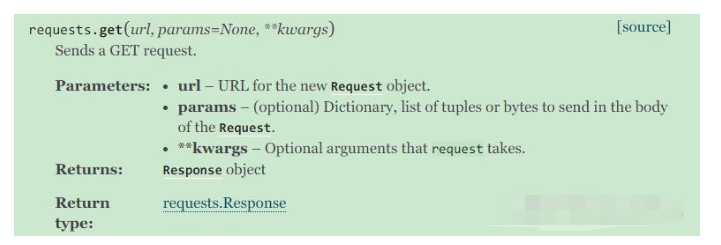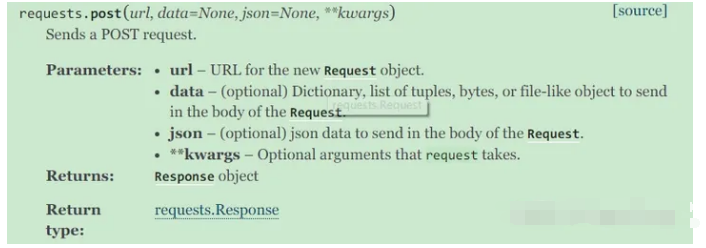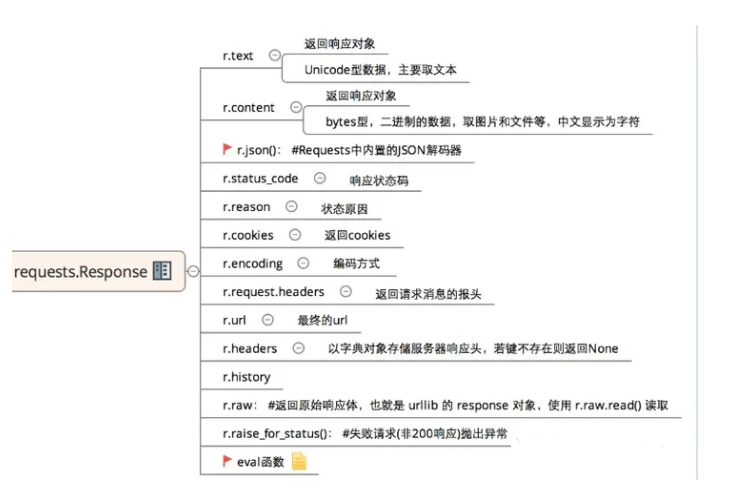Python接口自动化测试 —— Requests库学习
安装:
pip install requests例子:
-
import requests -
r = requests.get('http://www.baidu.com') -
print r.status_code -
print type(r) -
print r.cookies运行程序,得到结果:
运行程序,得到结果:
-
200 -
<class 'requests.models.Response'> -
<RequestsCookieJar[<Cookie BDORZ=27315 for .baidu.com/>]>
常用的HTTP请求类型
>>> r = requests.post('http://httpbin.org/post', data = {'key':'value'})
>>> r = requests.put('http://httpbin.org/put', data = {'key':'value'})
>>> r = requests.delete('http://httpbin.org/delete')
>>> r = requests.head('http://httpbin.org/get')
>>> r = requests.options('http://httpbin.org/get')
GET:

 ?
?
现在我也找了很多测试的朋友,做了一个分享技术的交流群,共享了很多我们收集的技术文档和视频教程。
如果你不想再体验自学时找不到资源,没人解答问题,坚持几天便放弃的感受
可以加入我们一起交流。而且还有很多在自动化,性能,安全,测试开发等等方面有一定建树的技术大牛
分享他们的经验,还会分享很多直播讲座和技术沙龙
可以免费学习!划重点!开源的!!!
qq群号:822269834
POST:
 ?API:
?API:

request库的返回内容
 ?返回响应对象
?返回响应对象
# r.text 当你访问 r.text 之时,Requests 会使用其推测的文本编码
>>> import requests
>>> r = requests.get('https://api.github.com/events')
>>> r.text
u'[{"repository":{"open_issues":0,"url":"https://github.com/...你可以找出 Requests 使用了什么编码,并且能够使用r.encoding?属性来改变它:
# r.encoding
>>> r.encoding
'utf-8'
>>> r.encoding = 'ISO-8859-1'二进制响应内容
# 以字节的方式访问请求响应体
>>> r.content
b'[{"repository":{"open_issues":0,"url":"https://github.com/...Json响应内容
# r.json JSON 解码失败, r.json() 就会抛出一个异常
>>> import requests
>>> r = requests.get('https://api.github.com/events')
>>> r.json()
[{u'repository': {u'open_issues': 0, u'url': 'https://github.com/...?Raw原始响应内容
# Note:确保在初始请求中设置了 stream=True
>>> r = requests.get('https://api.github.com/events', stream=True)
>>> r.raw
<requests.packages.urllib3.response.HTTPResponse object at 0x101194810>
>>> r.raw.read(10)
'\x1f\x8b\x08\x00\x00\x00\x00\x00\x00\x03'Header
>>> url = 'https://api.github.com/some/endpoint'
>>> payload = {'key1': 'value1', 'key2': 'value2'}
>>> headers = {'user-agent': 'my-app/0.0.1'}
>>> r = requests.get(url, params=payload, headers=headers)?响应状态码:
>>> r = requests.get('http://httpbin.org/get')
>>> r.status_code
200
# 内置的状态码查询对象
>>> r.status_code == requests.codes.ok
True
# 发送错误的请求时候,Response.raise_for_status() 来抛出异常
>>> bad_r = requests.get('http://httpbin.org/status/404')
>>> bad_r.status_code
404
>>> bad_r.raise_for_status()
Traceback (most recent call last):
File "requests/models.py", line 832, in raise_for_status
raise http_error
requests.exceptions.HTTPError: 404 Client Error
# 当status_code为200的时候
>>> r.raise_for_status()
NoneCookie:
>>> url = 'http://example.com/some/cookie/setting/url'
>>> r = requests.get(url)
>>> r.cookies['example_cookie_name']
'example_cookie_value'
# 发送cookie到服务器
>>> url = 'http://httpbin.org/cookies'
>>> cookies = dict(cookies_are='working')
>>> r = requests.get(url, cookies=cookies)
>>> r.text
'{"cookies": {"cookies_are": "working"}}'POST请求例子
传递参数方法:
import requests
payload = {'key1': 'value1', 'key2': 'value2'}
r = requests.post("http://httpbin.org/post", data=payload)
print r.text结果:
{
"args": {},
"data": "",
"files": {},
"form": {
"key1": "value1",
"key2": "value2"
},
"headers": {
"Accept": "*/*",
"Accept-Encoding": "gzip, deflate",
"Content-Length": "23",
"Content-Type": "application/x-www-form-urlencoded",
"Host": "httpbin.org",
"User-Agent": "python-requests/2.9.1"
},
"json": null,
"url": "http://httpbin.org/post"
}?把Json格式的数据传过去
import json
import requests
url = 'http://httpbin.org/post'
payload = {'some': 'data'}
r = requests.post(url, data=json.dumps(payload))
print r.text结果:
{
"args": {},
"data": "{\"some\": \"data\"}",
"files": {},
"form": {},
"headers": {
"Accept": "*/*",
"Accept-Encoding": "gzip, deflate",
"Content-Length": "16",
"Host": "httpbin.org",
"User-Agent": "python-requests/2.9.1"
},
"json": {
"some": "data"
},
"url": "http://httpbin.org/post"
}?如何上传一个文件呢?,新建一个txt文件,内容为:Hello Word!
import requests
url = 'http://httpbin.org/post'
files = {'file': open('test.txt', 'rb')}
r = requests.post(url, files=files)
print r.text运行结果:
{
"args": {},
"data": "",
"files": {
"file": "Hello World!"
},
"form": {},
"headers": {
"Accept": "*/*",
"Accept-Encoding": "gzip, deflate",
"Content-Length": "156",
"Content-Type": "multipart/form-data; boundary=7d8eb5ff99a04c11bb3e862ce78d7000",
"Host": "httpbin.org",
"User-Agent": "python-requests/2.9.1"
},
"json": null,
"url": "http://httpbin.org/post"
}文件就上传成功
另外一种流上传方式:
with open('massive-body') as f:
requests.post('http://some.url/streamed', data=f)超时:超时:
# requests 在经过以 timeout 参数设定的秒数时间之后停止等待响应
>>> requests.get('http://github.com', timeout=0.001)
Traceback (most recent call last):
File "<stdin>", line 1, in <module>
requests.exceptions.Timeout: HTTPConnectionPool(host='github.com', port=80): Request ?最后感谢每一个认真阅读我文章的人,看着粉丝一路的上涨和关注,礼尚往来总是要有的,虽然不是什么很值钱的东西,如果你用得到的话可以直接拿走!


?
本文来自互联网用户投稿,该文观点仅代表作者本人,不代表本站立场。本站仅提供信息存储空间服务,不拥有所有权,不承担相关法律责任。 如若内容造成侵权/违法违规/事实不符,请联系我的编程经验分享网邮箱:veading@qq.com进行投诉反馈,一经查实,立即删除!